Nonlinear Optical Response of Reflective MXene Molybdenum Carbide Films as Saturable Absorbers
Abstract
1. Introduction
2. Materials and Methods
2.1. Preparation of Mo2C SAs
2.2. Characterization of Mo2C SAs
3. Results and Discussion
3.1. Characterization of Mo2C SAs Film
3.2. Nonlinear Optical Characteristics of Mo2C SAs Film
3.3. Experimental Setup of Passively Q-Switched Nd:YAG Laser
3.4. Experimental Setup of Passively Q-Switched Nd:YVO4 Laser
4. Conclusions
Author Contributions
Funding
Acknowledgments
Conflicts of Interest
References
- Zuo, Y.; Gao, Y.R.S.; Qin, Y.; Wang, Z.Y.; Zhou, D.; Li, Z.; Yu, Y.; Shao, M.; Zhang, Y.L. Broadband multi-wavelength optical sensing based on photothermal effect of 2D MXene films. Nanophotonics 2020, 9, 123–131. [Google Scholar] [CrossRef]
- Zhang, M.; Wu, Q.; Zhang, F.; Chen, L.L.; Jin, X.X.; Hu, Y.W.; Zheng, Z.; Zhang, H. 2D black phosphorus saturable absorbers for ultrafast photonics. Adv. Opt. Mater. 2019, 7, 1800224. [Google Scholar] [CrossRef]
- Abdul Hadia, A.W.; Lau, K.Y.; Zainol Abidin, N.H.; Baki, S.O.; Ng, E.K.; Kee, L.H.; Mahdi, M.A. Investigation of tungsten trioxide as a saturable absorber for mode-locked generation. Opt. Laser Technol. 2020, 132, 106496. [Google Scholar] [CrossRef]
- Ge, Y.Q.; Zhu, Z.F.; Xu, T.H.; Chen, Y.X.; Chen, S.; Liang, Z.M.; Song, Y.F.; Zou, Y.S.; Zeng, H.B.; Xu, S.X.; et al. Broadband nonlinear photoresponse of 2D TiS2 for ultrashort pulse generation and all-optical thresholding devices. Adv. Opt. Mater. 2018, 6, 1701166. [Google Scholar] [CrossRef]
- Lu, L.; Liang, Z.M.; Wu, L.M.; Chen, Y.X.; Song, Y.F.; Dhanabalan, S.C.; Ponraj, J.S.; Dong, B.Q.; Xiang, Y.J.; Xing, F.; et al. Few-layer bismuthene: Sonochemical exfoliation, nonlinear optics and applications for ultrafast photonics with enhanced stability. Laser Photonics Rev. 2017, 12, 1700221. [Google Scholar] [CrossRef]
- Chen, Y.; Jiang, G.B.; Chen, S.Q.; Guo, Z.N.; Yu, X.F.; Zhao, C.J.; Zhang, H.; Bao, Q.L.; Wen, S.C.; Tang, D.Y.; et al. Mechanically exfoliated black phosphorus as a new saturable absorber for both Q-switching and Mode-locking laser operation. Opt. Express 2015, 23, 12823–12833. [Google Scholar] [CrossRef]
- Li, X.; Xu, J.; Wu, Y.; He, J.; Hao, X. Large energy laser pulses with high repetition rate by graphene Q-switched solid-state laser. Opt. Express 2011, 19, 9950–9955. [Google Scholar] [CrossRef]
- Yu, H.; Chen, X.; Zhang, H.; Hu, X.; Wang, Z.; Wang, J.; Zhuang, S.; Jiang, M. Large energy pulse generation modulated by graphene epitaxially grown on silicon carbide. ACS Nano 2010, 4, 7582–7586. [Google Scholar] [CrossRef] [PubMed]
- Xu, B.; Wang, Y.; Cheng, Y.; Yang, H.; Xu, H.; Cai, Z. Nanosecond pulse generation in a passively q-switched Nd:GGG laser at 1331 nm by CVD graphene saturable absorber. J. Opt. 2015, 17, 105501. [Google Scholar] [CrossRef]
- Shen, H.B.; Wang, Q.P.; Zhang, X.Y.; Liu, Z.J.; Bai, F.; Cong, Z.H.; Chen, X.H.; Gao, L.; Zhang, H.J.; Xu, X.G.; et al. Passively Q-switched Nd:KLu(WO4)2 laser at 1355 nm with graphene on SiC as saturable absorber. Appl. Phys. Express 2012, 5, 092703. [Google Scholar] [CrossRef]
- Wang, J.; Wang, Y.G.; Wang, T.J.; Li, G.Y.; Lou, R.; Cheng, G.H.; Bai, J. Nonlinear optical response of graphene oxide langmuir-blodgett film as saturable absorbers. Nanomaterials 2019, 9, 640. [Google Scholar] [CrossRef] [PubMed]
- Sun, Y.J.; Tu, C.Y.; You, Z.Y.; Liao, J.H.; Wang, Y.Q.; Xu, J.L. One-dimensional Bi2Te3 nanowire based broadband saturable absorber for passively Q-switched Yb-doped and Er-doped solid state lasers. Opt. Mater. Express 2018, 8, 165–174. [Google Scholar] [CrossRef]
- Hu, M.T.; Liu, J.H.; Tian, R.; Dou, Z.Y.; Song, T.R. Generation of Q-switched pulse by Bi2Te3 topological insulator in Yb:KGW laser. Laser Phys. Lett. 2014, 11, 115806. [Google Scholar] [CrossRef]
- Lin, Y.Y.; Lee, P.; Xu, J.; Wu, C.L.; Chou, C.M.; Tu, C. High-pulse-energy topological insulator Bi2Te3-based passive Q-switched solid-state laser. IEEE Photonics J. 2016, 8, 1–8. [Google Scholar] [CrossRef]
- Xu, B.; Wang, Y.; Peng, J.; Luo, Z.; Xu, H.; Cai, Z.; Weng, J. Topological insulator Bi2Se3 based Q-switched Nd:LiYF4 nanosecond laser at 1313 nm. Opt. Express 2015, 23, 7674–7680. [Google Scholar] [CrossRef] [PubMed]
- Lou, F.; Zhao, R.; He, J.; Jia, Z.; Su, X.; Wang, Z.; Hou, J.; Zhang, B. Nanosecond-pulsed, dual-wavelength, passively Q-switched ytterbium-doped bulk laser based on few-layer MoS2 saturable absorber. Photonics Res. 2015, 3, A25–A29. [Google Scholar] [CrossRef]
- Ge, P.G.; Liu, J.; Jiang, S.Z.; Xu, Y.Y.; Man, B.Y. Compact Q-switched 2 μm Tm:GdVO4 laser with MoS2 absorber. Photonics Res. 2015, 3, 256–259. [Google Scholar] [CrossRef]
- Wang, K.; Yang, K.J.; Zhang, X.Y.; Zhao, S.Z.; Luan, C.; Liu, C.; Wang, J.; Xu, X.D.; Xu, J. Passively Q-switched laser at 1.3 µm with few-layered MoS2 saturable absorber. IEEE J. Set. Top. Quant. 2017, 23, 1600205. [Google Scholar]
- Xu, B.; Cheng, Y.J.; Wang, Y.; Huang, Y.Z.; Peng, J.; Luo, Z.Q.; Xu, H.Y.; Cai, Z.P.; Weng, J.; Moncorgé, R. Passively Q-switched Nd:YAlO3 nanosecond laser using MoS2 as saturable absorber. Opt. Express 2014, 22, 28934–28940. [Google Scholar] [CrossRef]
- Ma, J.; Lu, S.; Guo, Z.; Xu, X.; Zhang, H.; Tang, D.; Fan, D. Few-layer black phosphorus based saturable absorber mirror for pulsed solid-state lasers. Opt. Express 2015, 23, 22643–22648. [Google Scholar] [CrossRef]
- Han, S.; Zhang, F.; Wang, M.; Wang, L.; Zhou, Y.; Wang, Z. Black phosphorus based saturable absorber for Nd-ion doped pulsed solid state laser operation. Indian J. Phys. 2016, 91, 1–5. [Google Scholar] [CrossRef]
- Sun, X.L.; Nie, H.K.; He, J.L.; Zhao, R.W.; Su, X.C.; Wang, Y.R.; Zhang, B.T.; Wang, R.H.; Yang, K.J. Passively Q-Switched Nd:GdVO4 1.3 μm laser with few-layered black phosphorus saturable absorber. IEEE J. Set. Top. Quant. 2018, 24, 1600405. [Google Scholar] [CrossRef]
- Wang, J.; Wang, Y.G.; Chen, Z.D.; Yang, X.G.; Lv, R.D. CH3NH3PbI3 perovskite thin films as a saturable absorber for a passively Q-switched Nd:YAG laser. J. Mater. Chem. C 2019, 7, 5047. [Google Scholar] [CrossRef]
- Naguib, M.; Kurtoglu, M.; Presse, V.; Lu, J.; Niu, J.; Heon, M.; Hult-man, L.; Gogotsi, Y.; Barsoum, M.W. Two-dimensional nanocrystals produced by exfoliation of Ti3AlC2. Adv. Mater. 2011, 23, 4248. [Google Scholar] [CrossRef] [PubMed]
- Shahzad, F.; Alhabeb, M.; Hatter, C.B.; Anasori, B.; Hong, S.M.; Koo, C.M.; Gogotsi, Y. Electromagnetic interference shielding with 2D transition metal carbides (MXenes). Science 2016, 353, 1137–1140. [Google Scholar] [CrossRef]
- Ling, Z.; Ren, C.E.; Zhao, M.Q.; Yang, J.; Giammarco, J.M.; Qiu, J.S.; Barsoum, M.W.; Gogotsi, Y. Flexible and conductive MXene films and nanocomposites with high capacitance. Proc. Natl. Acad. Sci. USA 2014, 111, 16676. [Google Scholar] [CrossRef]
- Hantanasirisakul, K.; Zhao, M.Q.; Urbankowski, P.; Halim, J.; Anasori, B.; Kota, S.; Ren, C.E.; Barsoum, M.W.; Gogotsi, Y. Fabrication of Ti3C2Tx MXene Transparent Thin Films with Tunable Optoelectronic Properties. Adv. Electron. Mater. 2016, 2, 1600050. [Google Scholar] [CrossRef]
- Zhu, M.; Huang, Y.; Deng, Q.; Zhou, J.; Pei, Z.; Xue, Q.; Huang, Y.; Wang, Z.; Li, H.; Huang, Q.; et al. Highly flexible, freestanding supercapacitor electrode with enhanced performance obtained by hybridizing polypyrrole chains with MXene. Adv. Energy Mater. 2016, 6, 1600969. [Google Scholar] [CrossRef]
- Lukatskaya, M.R.; Mashtalir, O.; Ren, C.E.; Dall’Agnese, Y.; Rozier, P.; Taberna, P.L.; Naguib, M.; Simon, P.; Barsoum, M.W.; Gogotsi, Y. Cation Intercalation and high volumetric capacitance of two-dimensional titanium carbide. Science 2013, 34, 1502–1505. [Google Scholar] [CrossRef]
- Young, I.J.; Koo, J.; Anasori, B.; Seo, M.; Lee, J.H.; Gogotsi, Y.; Jhon, Y.M. Metallic MXene saturable absorber for femtosecond mode-locked lasers. Adv. Mater. 2017, 29, 1702496. [Google Scholar]
- Jiang, X.T.; Liu, S.X.; Liang, W.Y.; Luo, S.J.; He, Z.L.; Ge, Y.Q.; Wang, H.D.; Cao, R.; Zhang, F.; Wen, Q.; et al. Broadband Nonlinear Photonics in Few-Layer MXene Ti3C2Tx (T = F, O, or OH). Laser Photon. Rev. 2018, 12, 1870013. [Google Scholar] [CrossRef]
- Feng, X.Y.; Ding, B.Y.; Liang, W.Y.; Zhang, F.; Ning, T.Y.; Liu, J.; Zhang, H. MXene Ti3C2Tx absorber for a 1.06 μm passively Q-switched ceramic laser. Laser Phys. Lett. 2018, 15, 085805. [Google Scholar] [CrossRef]
- Wang, C.; Peng, Q.Q.; Fan, X.W.; Liang, W.Y.; Zhang, F.; Liu, J.; Zhang, H. MXene Ti3C2Tx saturable absorber for pulsed laser at 1.3 µm. Chin. Phys. B 2018, 27, 094214. [Google Scholar] [CrossRef]
- Zu, Y.Q.; Zhang, C.; Guo, X.S.; Liang, W.Y.; Liu, J.; Su, L.B.; Zhang, H. A solid-state passively Q-switched Tm, Gd: CaF2 laser with a Ti3C2Tx MXene absorber near 2 µm. Laser Phys. Lett. 2019, 16, 015803. [Google Scholar] [CrossRef]
- Lin, H.L.; Shi, Z.P.; He, S.N.; Yu, X.; Wang, S.N.; Gao, Q.S.; Tang, Y. Heteronanowires of MoC–Mo2C as efficient electrocatalysts for hydrogen evolution reaction. Chem. Sci. 2016, 7, 3399–3405. [Google Scholar] [CrossRef] [PubMed]
- Dai, S.S.; Cheng, Y.; Quan, B.; Liang, X.H.; Liu, W.; Yang, Z.H.; Ji, G.B.; Du, T.W. Porous-carbon-based Mo2C nanocomposites as excellent microwave absorber: A new exploration. Nanoscale 2018, 10, 6945. [Google Scholar] [CrossRef]
- Tuo, M.F.; Xu, C.; Mu, H.R.; Bao, X.Z.; Wang, Y.W.; Xiao, S.; Ma, W.L.; Li, L.; Tang, D.Y.; Zhang, H.; et al. Ultrathin 2D transition metal carbides for ultrafast pulsed fiber lasers. ACS Photonics 2018, 5, 1808–1816. [Google Scholar] [CrossRef]
- Zhu, C.H.; Wang, F.Q.; Meng, Y.F.; Yuan, X.; Xiu, F.X.; Luo, H.Y.; Wang, Y.Z.; Li, J.F.; Lv, X.J.; He, L.; et al. A robust and tuneable mid-infrared optical switch enabled by bulk Dirac fermions. Nat. Commun. 2017, 8, 14111. [Google Scholar] [CrossRef]
- Wang, X.; Wang, Y.G.; Mao, D.; Li, L.; Chen, Z.D. Passively Q-switched Nd:YVO4 laser based on Fe3O4 nanoparticles saturable absorber. Opt. Mater. Express 2017, 7, 2913–2921. [Google Scholar] [CrossRef]
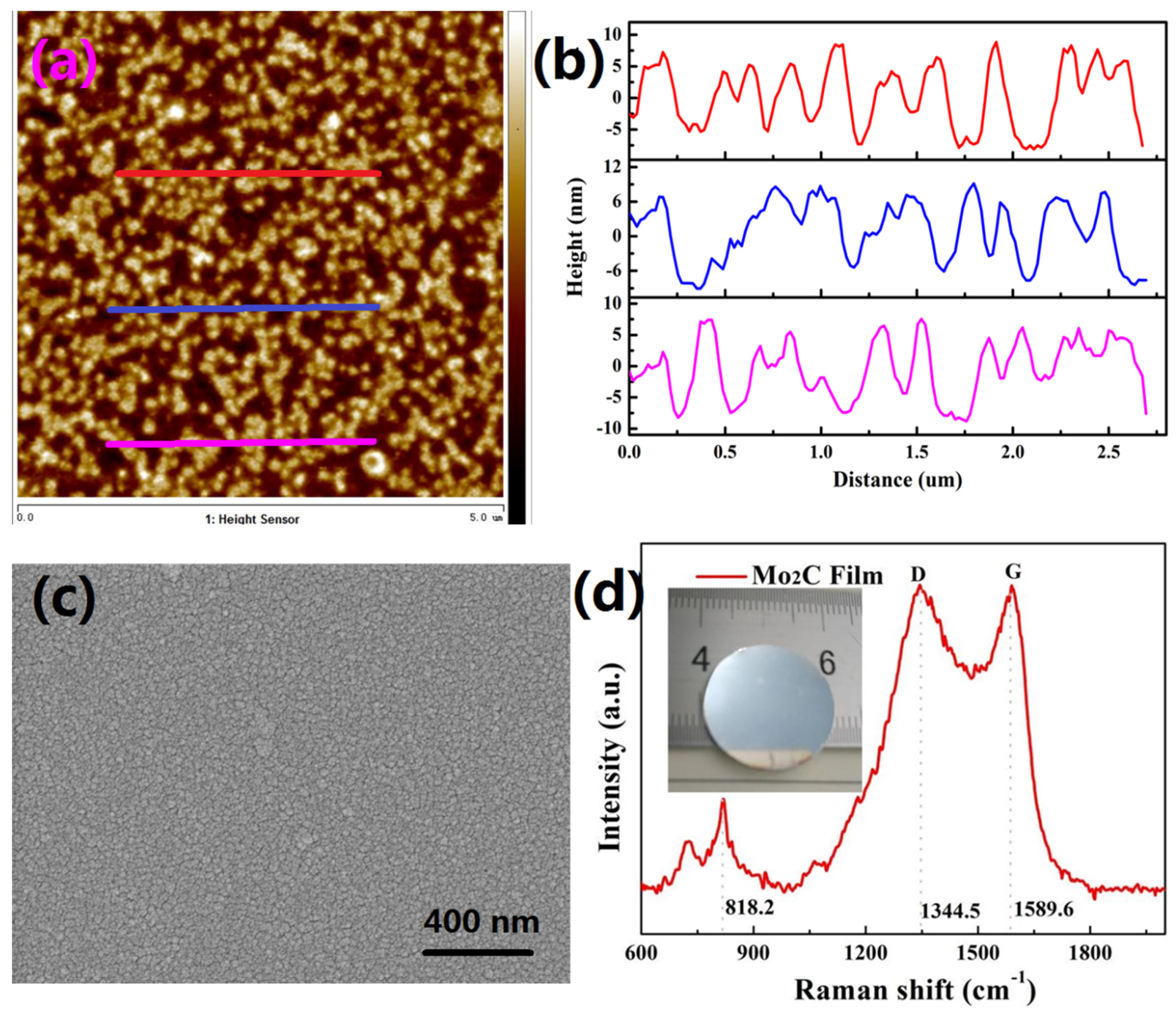
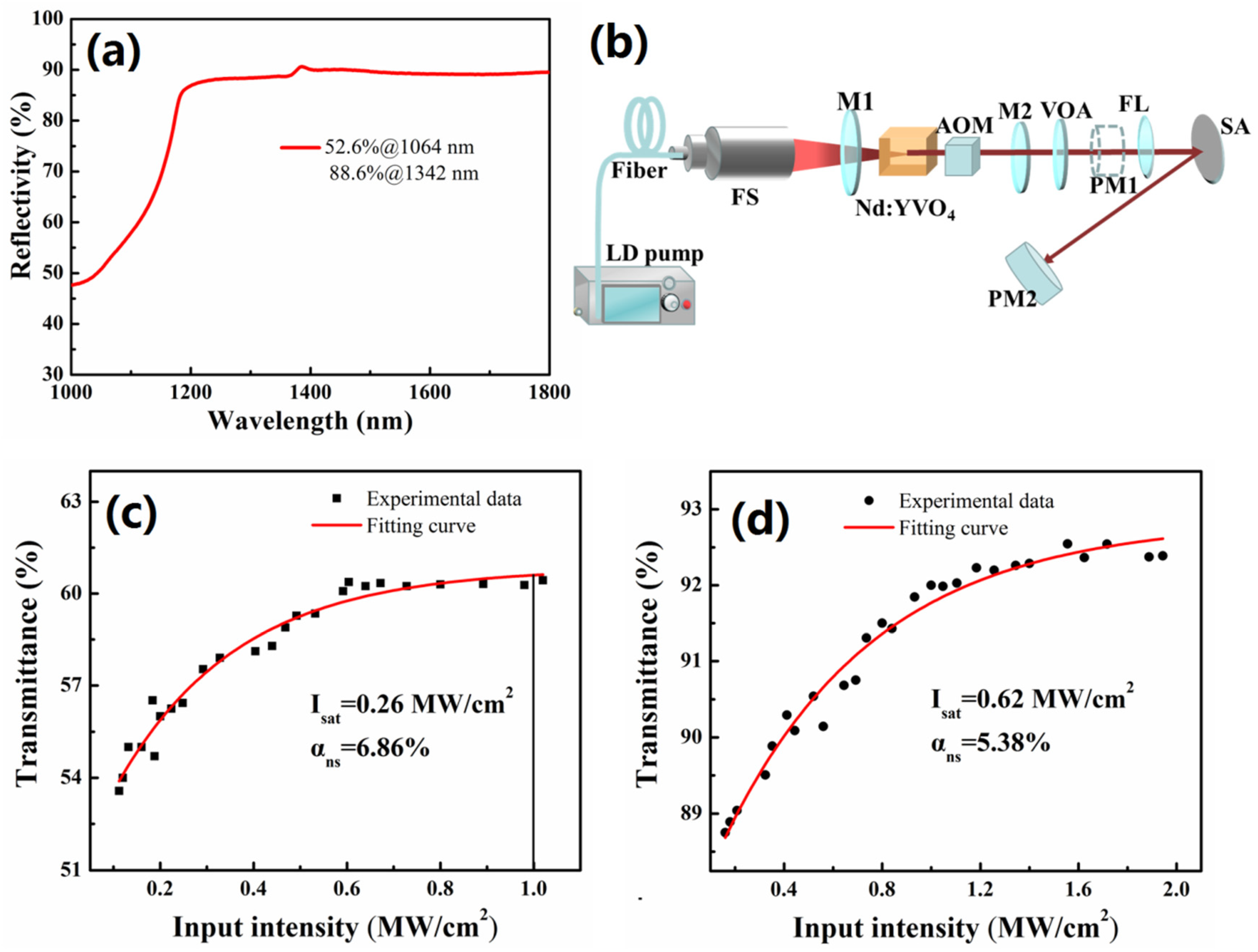
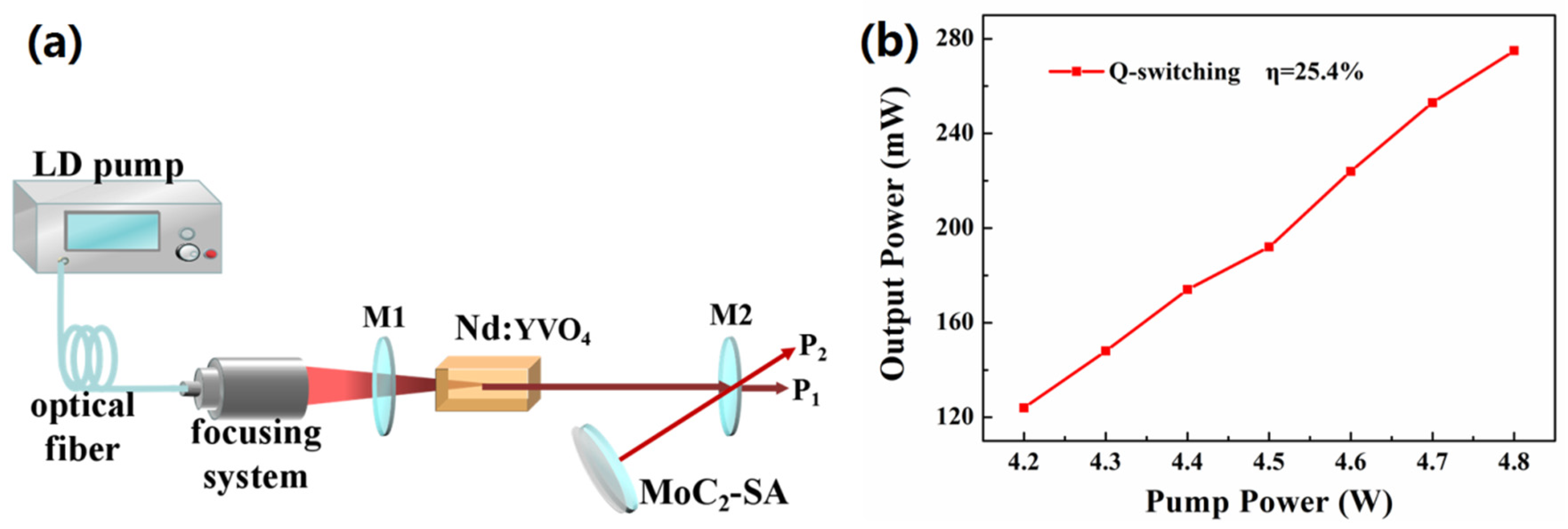
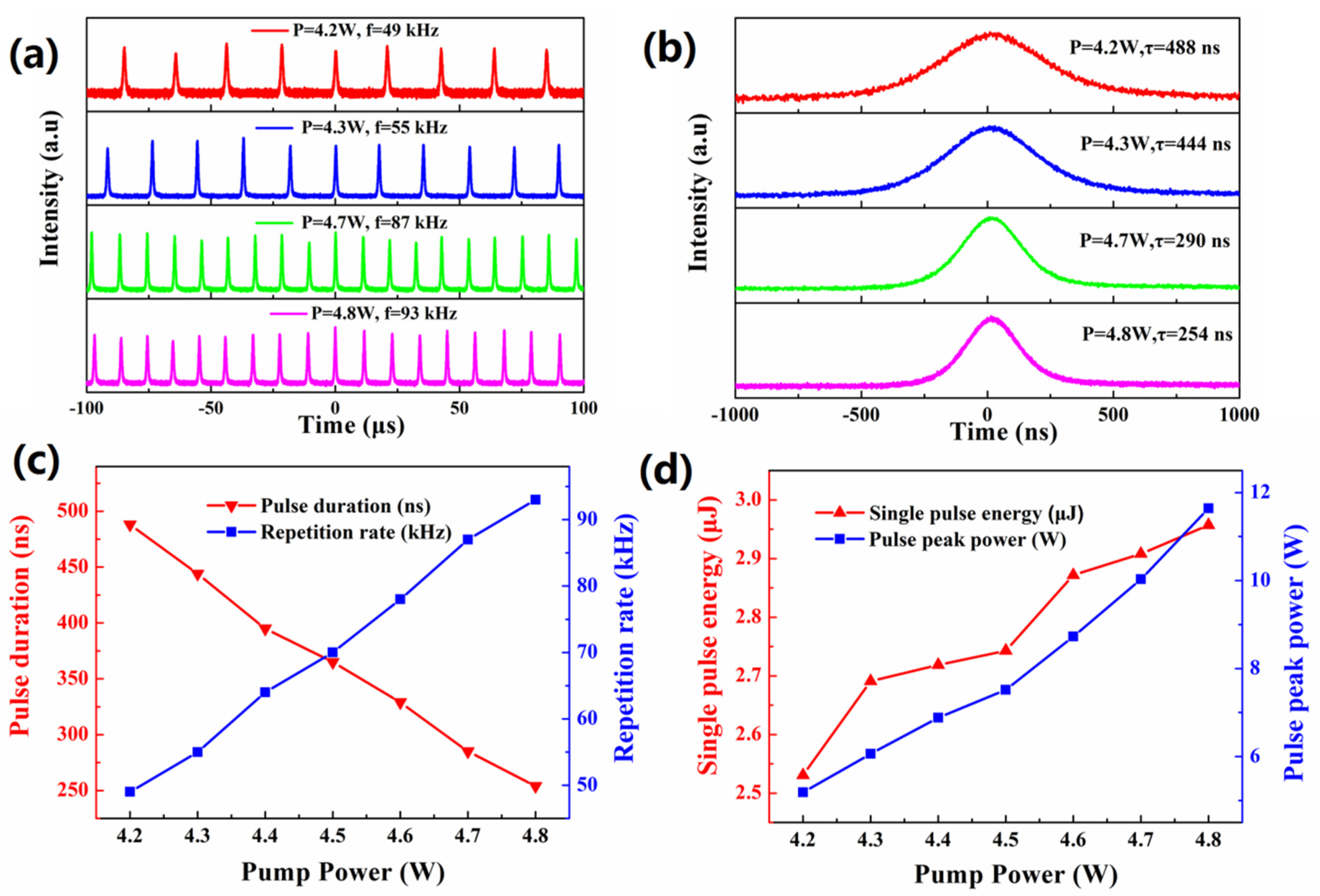
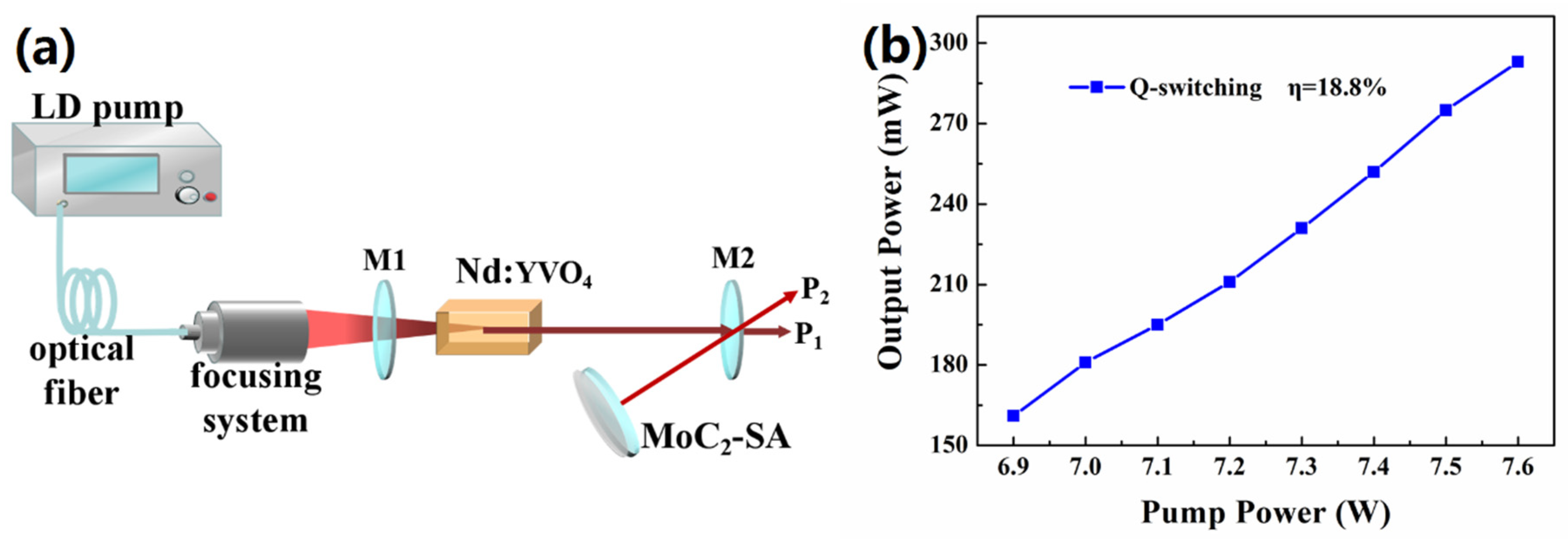
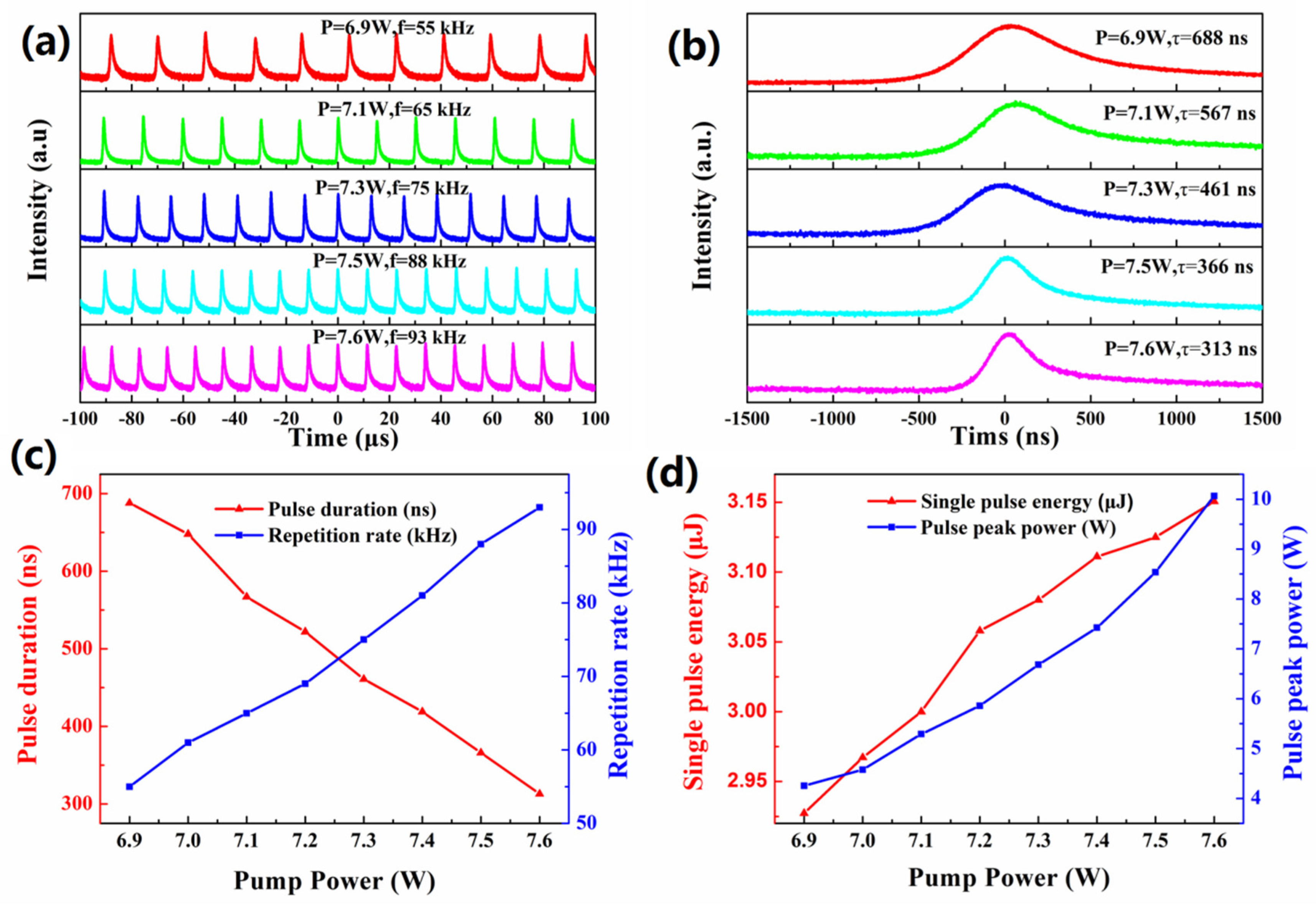
| SA Type | Laser Type | λ (μm) | τ (ns) | P (mW) | Ref. |
|---|---|---|---|---|---|
| Graphene | Nd:GdVO4 | 1.063 | 105 | 2300 | [7] |
| Graphene | Nd:YAG | 1.064 | 161 | 105 | [8] |
| Graphene | Nd:GGG | 1.331 | 556 | 690 | [9] |
| Graphene | Nd:KLu(WO4)2 | 1.335 | 466 | 890 | [10] |
| GO | Nd:YAG | 1.064 | 156 | 1331 | [11] |
| Bi2Te3 | Yb:GAB | 1.064 | 303 | 213 | [12] |
| Bi2Te3 | Yb:KGW | 1.041 | 1600 | 439 | [13] |
| Bi2Te3 | Nd:YAG | 1.3 | 673 | 326 | [14] |
| Bi2Te3 | Nd:LiYF4 | 1.313 | 443 | 198 | [15] |
| MoS2 | Yb:LGGG | 1.025 | 182 | 600 | [16] |
| MoS2 | Nd:LuAG | 1.342 | 188 | 180 | [18] |
| MoS2 | Nd:YAlO3 | 1.079 | 227 | 260 | [19] |
| WS2 | Nd:YVO4 | 1.064 | 2300 | 19.6 | [38] |
| BP | Yb:CYA | 1.046 | 620 | 37 | [20] |
| BP | Nd:GGG | 1.333 | 363 | 157 | [21] |
| Perovskite | Nd:YVO4 | 1.342 | 222 | 236 | [23] |
| Ti3C2Tx | Nd:YAG | 1.064 | 359 | 94.8 | [32] |
| Ti3C2Tx | Nd:YVO4 | 1.3 | 454 | 30 | [33] |
| Ti3C2Tx | Tm, Gd:CaF2 | 1.929 | 2390 | 208 | [34] |
| Mo2C | Nd:YAG | 1.064 | 254 | 275 | Our work |
| Mo2C | Nd:YVO4 | 1.342 | 313 | 293 | Our work |
Publisher’s Note: MDPI stays neutral with regard to jurisdictional claims in published maps and institutional affiliations. |
© 2020 by the authors. Licensee MDPI, Basel, Switzerland. This article is an open access article distributed under the terms and conditions of the Creative Commons Attribution (CC BY) license (http://creativecommons.org/licenses/by/4.0/).
Share and Cite
Wang, J.; Wang, Y.; Liu, S.; Li, G.; Zhang, G.; Cheng, G. Nonlinear Optical Response of Reflective MXene Molybdenum Carbide Films as Saturable Absorbers. Nanomaterials 2020, 10, 2391. https://doi.org/10.3390/nano10122391
Wang J, Wang Y, Liu S, Li G, Zhang G, Cheng G. Nonlinear Optical Response of Reflective MXene Molybdenum Carbide Films as Saturable Absorbers. Nanomaterials. 2020; 10(12):2391. https://doi.org/10.3390/nano10122391
Chicago/Turabian StyleWang, Jiang, Yonggang Wang, Sicong Liu, Guangying Li, Guodong Zhang, and Guanghua Cheng. 2020. "Nonlinear Optical Response of Reflective MXene Molybdenum Carbide Films as Saturable Absorbers" Nanomaterials 10, no. 12: 2391. https://doi.org/10.3390/nano10122391
APA StyleWang, J., Wang, Y., Liu, S., Li, G., Zhang, G., & Cheng, G. (2020). Nonlinear Optical Response of Reflective MXene Molybdenum Carbide Films as Saturable Absorbers. Nanomaterials, 10(12), 2391. https://doi.org/10.3390/nano10122391




